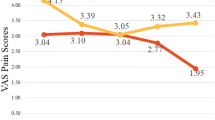Abstract
Introduction
The opioid epidemic in the United States is an ongoing public health crisis that is in part fueled by excessive prescribing by physicians. Percutaneous nephrolithotomy (PCNL) is a procedure that conventionally involves opioid prescriptions for adequate post-operative pain control. We aimed to evaluate the feasibility of a non-opioid pain regimen by evaluating post-operative outcomes in PCNL patients discharged without opioids.
Materials and methods
As a quality improvement measure to reduce opioid consumption our department began routinely prescribing oral ketorolac instead of oxycodone–acetaminophen for pain control after PCNL. We retrospectively compared patients undergoing PCNL who had received ketorolac prescriptions (NSAID) to those who received oxycodone–acetaminophen prescriptions (NARC). Demographic, operative, and post-operative factors were obtained and compared in both groups. Peri-operative factors and demographics were compared using either Chi-squared tests, Mann–Whitney U tests. Surgical outcomes were compared between the two groups using Chi-squared tests and Fisher’s exact tests. Multivariate logistic regression analysis was performed to determine whether ketorolac use was an independent predictor of post-surgical pain-related encounters. Primary outcome was unplanned pain-related healthcare encounters inclusive of office phone calls, unscheduled office visits, and emergency department (ED) visits. Secondary outcome measures were non-pain-related healthcare encounters, hospital readmissions, pain-related rescue medications prescribed, and post-op complications.
Results
There were similar demographics and peri-operative characteristics amongst patients in both cohorts. There was no significant difference identified between NSAID and NARC regarding unplanned pain-related encounters (8/70, 11.4% vs. 10/70, 14.3%, p = 0.614). However, NARC experienced more unplanned phone calls (42, 60% vs. 24, 34.3%, p = 0.004). Multivariate analysis revealed only prior stone surgery was predictive of pain-related encounters after PCNL (p = 0.035).
Conclusion
Our results show that there were no significant differences in pain-related encounters between those who received ketorolac and oxycodone–acetaminophen following PCNL. A non-opioid pathway may mitigate the potential risk associated with opioid prescription without compromising analgesia. Prospective comparative studies are warranted to confirm feasibility.
Similar content being viewed by others
Data availability
Data available on request from the authors.
Abbreviations
- PCNL:
-
Percutaneous nephrolithotomy
- NSAID:
-
Ketorolac group
- NARC:
-
Oxycodone-acetaminophen group
- ED:
-
Emergency department
References
Leapman MS, DeRycke E, Skanderson M et al (2018) Variation in national opioid prescribing patterns following surgery for kidney stones. Pain Med 19(suppl_1):S12–S18. https://doi.org/10.1093/pm/pny125
Serna J, Talwar R, Lee DJ (2020) Reducing opioid use after endourologic procedures. Curr Urol Rep 21(5):20. https://doi.org/10.1007/s11934-020-00975-2
Kalso E, Edwards JE, Moore AR, McQuay HJ (2004) Opioids in chronic non-cancer pain: systematic review of efficacy and safety. Pain 112(3):372–380. https://doi.org/10.1016/j.pain.2004.09.019
Rudd RA, Seth P, David F, Scholl L (2016) Increases in drug and opioid-involved overdose deaths United States, 2010–2015. MMWR Morb Mortal Wkly Rep 65(50–51):1445–1452. https://doi.org/10.15585/mmwr.mm655051e1
Bamberger JN, Gallante B, Khusid JA et al (2022) A prospective randomized study evaluating the necessity of narcotics following ureteroscopy for urinary stone disease. World J Urol 40(10):2567–2573. https://doi.org/10.1007/s00345-022-04099-9
Fedrigon D, Faris A, Kachroo N et al (2021) SKOPE-study of ketorolac vs opioid for pain after endoscopy: a double-blinded randomized control trial in patients undergoing ureteroscopy. J Urol 206(2):373–381. https://doi.org/10.1097/ju.0000000000001772
Demasi M, Segall M, Mengotto A et al (2022) Optimizing pain management following kidney stone surgery: can we avoid narcotics? World J Urol. https://doi.org/10.1007/s00345-022-04214-w
Large T, Heiman J, Ross A, Anderson B, Krambeck A (2018) Initial experience with narcotic-free ureteroscopy: a feasibility analysis. J Endourol 32(10):907–911. https://doi.org/10.1089/end.2018.0459
Shah AS, Blackwell RH, Kuo PC, Gupta GN (2017) Rates and risk factors for opioid dependence and overdose after urological surgery. J Urol 198(5):1130–1136. https://doi.org/10.1016/j.juro.2017.05.037
Bates C, Laciak R, Southwick A, Bishoff J (2011) Overprescription of postoperative narcotics: a look at postoperative pain medication delivery, consumption and disposal in urological practice. J Urol 185(2):551–555. https://doi.org/10.1016/j.juro.2010.09.088
Author information
Authors and Affiliations
Contributions
RK: protocol/project development, data collection or management, data analysis, manuscript writing. AY: protocol/project development, data collection or management, data analysis, manuscript writing. RB: protocol/project development, data collection or management, manuscript writing. AR: data collection or management, data analysis. CC: data collection or management, data analysis. BG: data analysis. JK: data collection or management. WA: data collection or management. MG: protocol/project development, data collection or management, data analysis, manuscript writing.
Corresponding author
Ethics declarations
Conflict of interest
The authors declare that they have no conflict of interest.
Ethical approval
The study was approved by the Institutional Review Board and necessary informed consent was collected from all participants.
Consent to participate
Not applicable.
Consent for publication
Not applicable.
Additional information
Publisher's Note
Springer Nature remains neutral with regard to jurisdictional claims in published maps and institutional affiliations.
Rights and permissions
Springer Nature or its licensor (e.g. a society or other partner) holds exclusive rights to this article under a publishing agreement with the author(s) or other rightsholder(s); author self-archiving of the accepted manuscript version of this article is solely governed by the terms of such publishing agreement and applicable law.
About this article
Cite this article
Khargi, R., Yaghoubian, A.J., Blake, R.M. et al. Opioid-free percutaneous nephrolithotomy: an initial experience. World J Urol 41, 3113–3119 (2023). https://doi.org/10.1007/s00345-023-04600-y
Received:
Accepted:
Published:
Issue Date:
DOI: https://doi.org/10.1007/s00345-023-04600-y




